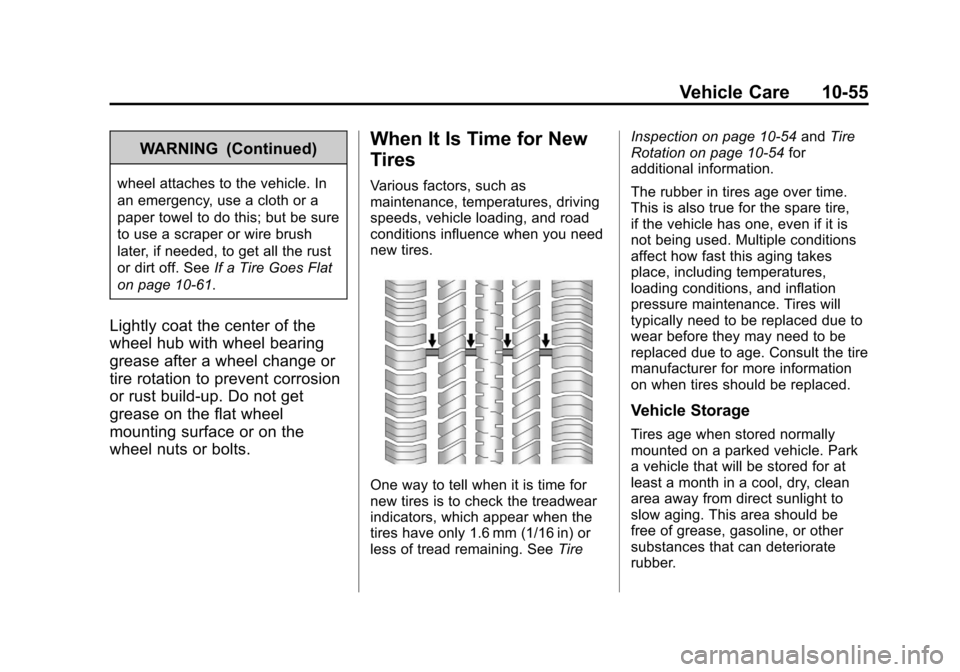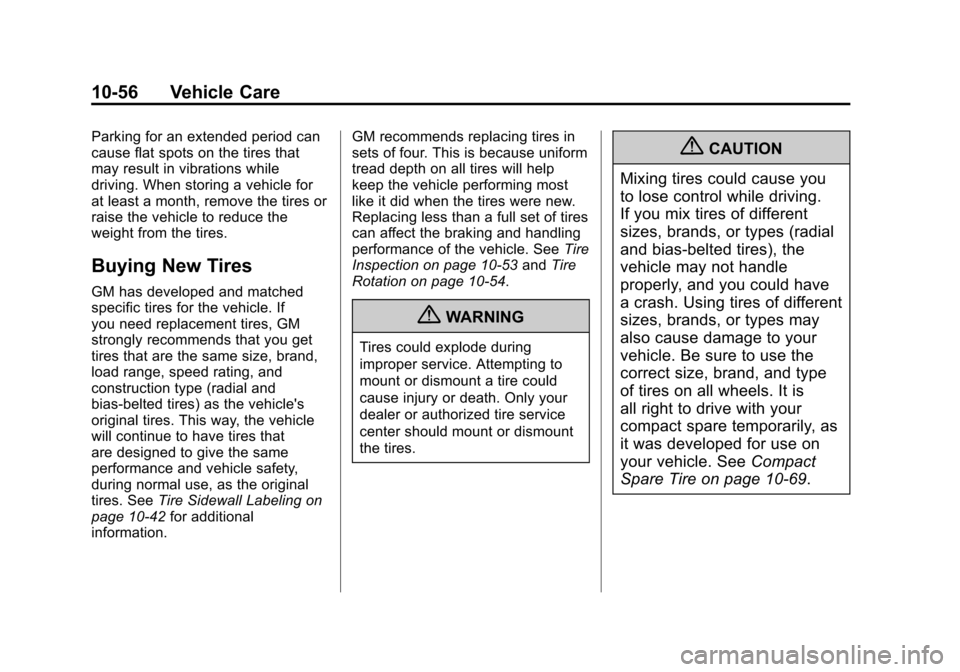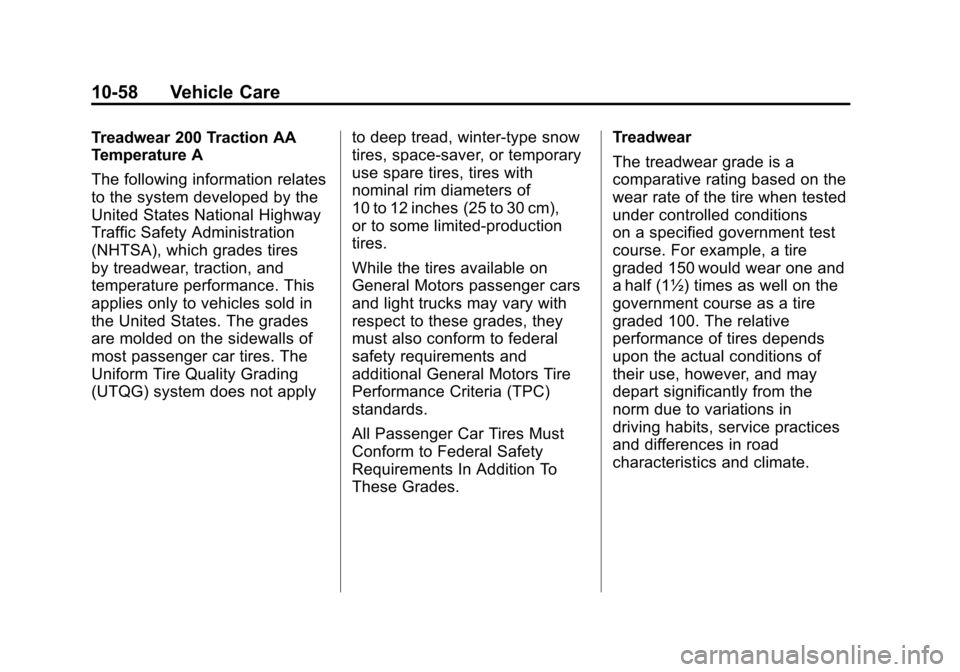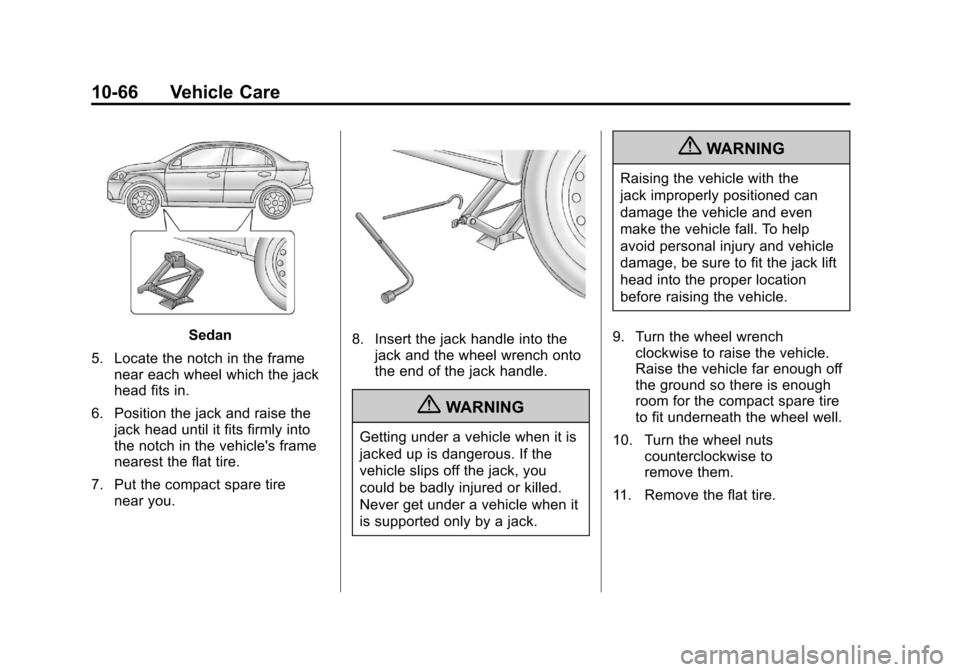Page 256 of 328

Black plate (54,1)Chevrolet Aveo Owner Manual - 2011
10-54 Vehicle Care
Tire Rotation
Tires should be rotated every
12 000 km (7,500 miles). See
Scheduled Maintenance on
page 11‑2.
The purpose of a regular tire
rotation is to achieve a uniform
wear for all tires on the vehicle.
This will ensure that your vehicle
continues to perform most like it
did when the tires were new.
Any time you notice unusual
wear, rotate your tires as soon
as possible and check wheel
alignment. Also check for
damaged tires or wheels. See
When It Is Time for New Tires
on page 10‑55andWheel
Replacement on page 10‑60 for
more information.
When rotating your tires, always
use the correct rotation pattern
shown here.
Do not include the compact
spare tire in the tire rotation.
After the tires have been
rotated, adjust the front and rear
inflation pressures as shown on
the tire and loading information
label. See Vehicle Load Limits
on page 9‑12 for an example of
the Tire and Loading Information
label and where it is located on
your vehicle. Make certain that all wheel nuts are properly
tightened. See
“Wheel Nut
Torque” underCapacities and
Specifications on page 12‑2.
See your dealer to reset the Tire
Pressure Monitor System
(TPMS) after rotating the tires,
if a tire pressure monitor
reception error occurs.
{WARNING
Rust or dirt on a wheel, or on the
parts to which it is fastened, can
make wheel nuts become loose
after time. The wheel could come
off and cause an accident. When
changing a wheel, remove any
rust or dirt from places where the
(Continued)
Page 257 of 328

Black plate (55,1)Chevrolet Aveo Owner Manual - 2011
Vehicle Care 10-55
WARNING (Continued)
wheel attaches to the vehicle. In
an emergency, use a cloth or a
paper towel to do this; but be sure
to use a scraper or wire brush
later, if needed, to get all the rust
or dirt off. SeeIf a Tire Goes Flat
on page 10‑61.
Lightly coat the center of the
wheel hub with wheel bearing
grease after a wheel change or
tire rotation to prevent corrosion
or rust build-up. Do not get
grease on the flat wheel
mounting surface or on the
wheel nuts or bolts.
When It Is Time for New
Tires
Various factors, such as
maintenance, temperatures, driving
speeds, vehicle loading, and road
conditions influence when you need
new tires.
One way to tell when it is time for
new tires is to check the treadwear
indicators, which appear when the
tires have only 1.6 mm (1/16 in) or
less of tread remaining. See TireInspection on page 10‑54
andTire
Rotation on page 10‑54 for
additional information.
The rubber in tires age over time.
This is also true for the spare tire,
if the vehicle has one, even if it is
not being used. Multiple conditions
affect how fast this aging takes
place, including temperatures,
loading conditions, and inflation
pressure maintenance. Tires will
typically need to be replaced due to
wear before they may need to be
replaced due to age. Consult the tire
manufacturer for more information
on when tires should be replaced.
Vehicle Storage
Tires age when stored normally
mounted on a parked vehicle. Park
a vehicle that will be stored for at
least a month in a cool, dry, clean
area away from direct sunlight to
slow aging. This area should be
free of grease, gasoline, or other
substances that can deteriorate
rubber.
Page 258 of 328

Black plate (56,1)Chevrolet Aveo Owner Manual - 2011
10-56 Vehicle Care
Parking for an extended period can
cause flat spots on the tires that
may result in vibrations while
driving. When storing a vehicle for
at least a month, remove the tires or
raise the vehicle to reduce the
weight from the tires.
Buying New Tires
GM has developed and matched
specific tires for the vehicle. If
you need replacement tires, GM
strongly recommends that you get
tires that are the same size, brand,
load range, speed rating, and
construction type (radial and
bias‐belted tires) as the vehicle's
original tires. This way, the vehicle
will continue to have tires that
are designed to give the same
performance and vehicle safety,
during normal use, as the original
tires. SeeTire Sidewall Labeling on
page 10‑42 for additional
information. GM recommends replacing tires in
sets of four. This is because uniform
tread depth on all tires will help
keep the vehicle performing most
like it did when the tires were new.
Replacing less than a full set of tires
can affect the braking and handling
performance of the vehicle. See
Tire
Inspection on page 10‑53 andTire
Rotation on page 10‑54.
{WARNING
Tires could explode during
improper service. Attempting to
mount or dismount a tire could
cause injury or death. Only your
dealer or authorized tire service
center should mount or dismount
the tires.
{CAUTION
Mixing tires could cause you
to lose control while driving.
If you mix tires of different
sizes, brands, or types (radial
and bias-belted tires), the
vehicle may not handle
properly, and you could have
a crash. Using tires of different
sizes, brands, or types may
also cause damage to your
vehicle. Be sure to use the
correct size, brand, and type
of tires on all wheels. It is
all right to drive with your
compact spare temporarily, as
it was developed for use on
your vehicle. See Compact
Spare Tire on page 10‑69.
Page 260 of 328

Black plate (58,1)Chevrolet Aveo Owner Manual - 2011
10-58 Vehicle Care
Treadwear 200 Traction AA
Temperature A
The following information relates
to the system developed by the
United States National Highway
Traffic Safety Administration
(NHTSA), which grades tires
by treadwear, traction, and
temperature performance. This
applies only to vehicles sold in
the United States. The grades
are molded on the sidewalls of
most passenger car tires. The
Uniform Tire Quality Grading
(UTQG) system does not applyto deep tread, winter-type snow
tires, space-saver, or temporary
use spare tires, tires with
nominal rim diameters of
10 to 12 inches (25 to 30 cm),
or to some limited-production
tires.
While the tires available on
General Motors passenger cars
and light trucks may vary with
respect to these grades, they
must also conform to federal
safety requirements and
additional General Motors Tire
Performance Criteria (TPC)
standards.
All Passenger Car Tires Must
Conform to Federal Safety
Requirements In Addition To
These Grades.Treadwear
The treadwear grade is a
comparative rating based on the
wear rate of the tire when tested
under controlled conditions
on a specified government test
course. For example, a tire
graded 150 would wear one and
a half (1½) times as well on the
government course as a tire
graded 100. The relative
performance of tires depends
upon the actual conditions of
their use, however, and may
depart significantly from the
norm due to variations in
driving habits, service practices
and differences in road
characteristics and climate.
Page 266 of 328
Black plate (64,1)Chevrolet Aveo Owner Manual - 2011
10-64 Vehicle Care
Tire Changing
Removing the Spare Tire and
Tools
The compact spare tire and tools
you will need are located in the
trunk.
A. Jack
B. Wheel Wrench
C. Jack Handle
D. Screwdriver (if equipped)1. Open the trunk or liftgate. See
Trunk on page 2‑7 orLiftgate
(Hatchback) on page 2‑9.
2. Lift the trim cover.
3. Remove the foam tray.
4. Remove the jack, the jack handle, and the wheel wrench
from the foam tray.
5. Turn the retainercounterclockwise and remove it
from the compact spare.
6. Remove the compact spare tire. See Compact Spare Tire on
page 10‑69 for more information.
Page 267 of 328
Black plate (65,1)Chevrolet Aveo Owner Manual - 2011
Vehicle Care 10-65
Removing the Flat Tire and
Installing the Spare Tire
1. Do a safety check beforeproceeding. See If a Tire Goes
Flat on page 10‑61.
2. If your vehicle has wheel covers, turn the four plastic caps
counterclockwise by hand or by
using the wheel wrench. The
plastic nuts do not come off of
the cover.
3. Remove the wheel cover using the flat end of the jack handle.
Pry along the edge of the wheel
cover until it comes off.
Store the wheel cover in the
cargo area until you have the flat
tire repaired or replaced.
4. Turn the wheel nutscounterclockwise to loosen
them. Do not remove them yet.Hatchback
Page 268 of 328

Black plate (66,1)Chevrolet Aveo Owner Manual - 2011
10-66 Vehicle Care
Sedan
5. Locate the notch in the frame near each wheel which the jack
head fits in.
6. Position the jack and raise the jack head until it fits firmly into
the notch in the vehicle's frame
nearest the flat tire.
7. Put the compact spare tire near you.8. Insert the jack handle into thejack and the wheel wrench onto
the end of the jack handle.
{WARNING
Getting under a vehicle when it is
jacked up is dangerous. If the
vehicle slips off the jack, you
could be badly injured or killed.
Never get under a vehicle when it
is supported only by a jack.
{WARNING
Raising the vehicle with the
jack improperly positioned can
damage the vehicle and even
make the vehicle fall. To help
avoid personal injury and vehicle
damage, be sure to fit the jack lift
head into the proper location
before raising the vehicle.
9. Turn the wheel wrench clockwise to raise the vehicle.
Raise the vehicle far enough off
the ground so there is enough
room for the compact spare tire
to fit underneath the wheel well.
10. Turn the wheel nuts counterclockwise to
remove them.
11. Remove the flat tire.
Page 269 of 328
Black plate (67,1)Chevrolet Aveo Owner Manual - 2011
Vehicle Care 10-67
{WARNING
Rust or dirt on a wheel, or on the
parts to which it is fastened, can
make wheel nuts become loose
after time. The wheel could come
off and cause an accident. When
changing a wheel, remove any
rust or dirt from places where the
wheel attaches to the vehicle. In
an emergency, use a cloth or a
paper towel to do this; but be sure
to use a scraper or wire brush
later, if needed, to get all the rust
or dirt off. SeeIf a Tire Goes Flat
on page 10‑61.
12. Remove any rust or dirt from the wheel bolts, mounting
surfaces and spare wheel.
13. Place the compact spare tire on the wheel-mounting surface.
{WARNING
Never use oil or grease on bolts
or nuts because the nuts might
come loose. The vehicle's wheel
could fall off, causing a crash.
14. Install the wheel nuts with the rounded end of the nuts toward
the wheel. Tighten each nut by
hand clockwise until the wheel
is held against the hub.